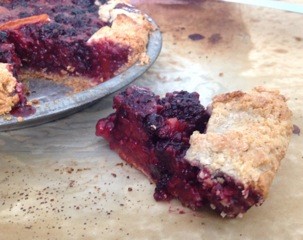 Oatmeal Crust (adapted from the King Arthur Baking Book) (fills one 9" pie plate) 2/3 cup old-fashioned oats 1/2 cup all-purpose flour 1/2 cup 'white' whole wheat flour 1/4 teaspoon baking powder 1 teaspoon sugar 1/4 teaspoon kosher salt 1/2 cup cold unsalted butter, cut into small pieces 1 teaspoon cider vinegar 5-6 tablespoons ice water In the bowl of a food processor fitted with the blade attachment, combine oats, both flours, baking powder, sugar and salt and pulse a few times to combine. Add the cold butter and pulse until mixture becomes crumbly. Add the cider vinegar and 5 tablespoons of the ice water, pulsing just until the mixture starts to form a soft dough. If the mixture feels dry, you can add up to one additional tablespoon of ice water. Scrape the dough out onto a piece of plastic wrap, pat into a disc, wrap and refrigerate for at least 30 minutes before rolling out. Place chilled dough on a sheet of parchment paper that has been lightly dusted with either white or whole wheat flour. Roll the dough into a circle, about 12 to 13 inches wide. Place the dough into a 9" pie plate (do not use a deep dish plate; my pie plate measures 1 and 1/4" deep.) Let the dough drape over the sides of the pie plate; do not crimp. Set aside while you prepare the filling. Preheat your oven to 425 degrees. Jumble Berry filling with a handful of Fresh Apricots 7 cups total of fruit (I used one package of Trader Joes frozen mixed berry medley, fresh blackberries that I had on hand and a few fresh apricots sliced in wedges. You can also make this with frozen raspberries and fresh peaches.) 1 cup granulated sugar 3 tablespoons light or dark brown sugar 1/2 teaspoon cinnamon 1/8 teaspoon freshly grated nutmeg 5 tablespoons cornstarch zest of 1 small lemon Place the fruit in a large bowl and use your fingers to gently break the fruit apart so it is not frozen in one big clump. In a medium bowl, whisk together the sugar, brown sugar, cinnamon, nutmeg, cornstarch and lemon zest. Pour this over the fruit and use a rubber spatula to gently combine, making sure the frozen berries and sugar are well mixed. Place the fruit mixture into the pie plate, spreading it evenly with an offset spatula. Gently use your fingers to bring the overhang of dough up and over the edge of the filling, as you would if your were making a free-form tart or galette. Sprinkle the edge of the crust with sugar, if you wish. Place on a parchment lined baking sheet and bake at 425 degrees for 15 minutes. Reduce the heat to 375 degrees and bake for an additional 50 minutes or a bit more, until the filling is bubbling thickly and the crust is golden. If you can wait, it is best to let this cool on a rack for at least one hour before slicing.
0 Comments
Sweet Crust (will fit a 9” pie plate or a 9” free form tart ring with some scraps remaining) (from Pleasures of Cooking)
1½ cups all-purpose flour ¼ cup sugar a pinch of kosher salt 4 oz. (1 stick) cold unsalted butter, cut into pieces 1 egg, lightly beaten In a small bowl or ramekin, whisk together the egg. In the bowl of a food processor fitted with the blade attachment, pulse together the flour, sugar and salt. Add the butter and process just until the mixture forms coarse crumbs. Add the egg and pulse just until the dough comes together. Do not over mix. Scrape the dough onto a piece of plastic wrap, pat it into a disc, wrap and refrigerate for 30 minutes before rolling out. Roll out the chilled dough onto a piece of lightly floured parchment paper; fit the dough into the pie plate or tart ring, trim/crimp the edges and refrigerate until firm. Preheat your oven to 375 degrees. Line the pie plate or tart ring with parchment paper and beans; blind bake at 375 degrees for 10-15 minutes, remove the beans and parchment and bake an additional 10 minutes, checking to make sure it isn’t getting too brown. Set aside to cool completely. Tart Lemon Curd (adapted from Taste by Williams-Sonoma) 3 whole eggs + 3 egg yolks, lightly beaten ¾ cup sugar 1 tablespoon cornstarch ¾ cup fresh lemon juice, strained 2 tablespoons lemon zest 6 oz. (1½ sticks) unsalted butter, cut into small pieces In the top of a double boiler, whisk together the eggs, egg yolks, sugar, and cornstarch. Gradually whisk in the lemon juice and zest, and set the double boiler over boiling water. Cook the mixture, stirring constantly with a rubber spatula until thick enough to coat the back of the spatula. This will take a good 10-15 minutes, maybe a bit more. Add the butter, a few pieces at a time and whisk until smooth. Strain the lemon curd through a fine mesh strainer placed over a bowl. Pour the lemon curd into the fully baked and cooled pie or tart shell. Spread evenly with an offset spatula. Place plastic wrap on top of the pie/tart and refrigerate until chilled, 2 to 3 hours. Before serving, remove the plastic wrap and gently dab the top of the pie/tart with a paper towel to remove moisture. Sprinkle with caramelized sugar (see details below) and use a kitchen torch to brûlée the top. Once you have torched the top, the crispy sugar is short-lived when placed back in the refrigerator. In honor of National Pie Day, I encourage you to perform a random act of pie-ness, and share with a friend. How to Brûlée- Grease a sheet of aluminum foil and place it on a baking pan. Set aside. In a heavy bottomed high-sided saucepan, melt one cup of granulated sugar over low heat until it caramelizes. (Don’t turn your back on the sugar or walk away; that is when the sugar will burn.) The color should be close to the color of maple syrup, amber. Outfit your hand in an oven mitt and carefully pour the sugar on top of the greased aluminum foil. Let the sugar harden completely. When it is cool, break the sugar into pieces. Place the pieces of caramelized sugar into the bowl of a food processor fitted with the blade attachment. Pulverize the sugar and transfer to a small bowl. Sprinkle a few tablespoons of the pulverized sugar evenly over the pie and have a go at it with your handheld torch. 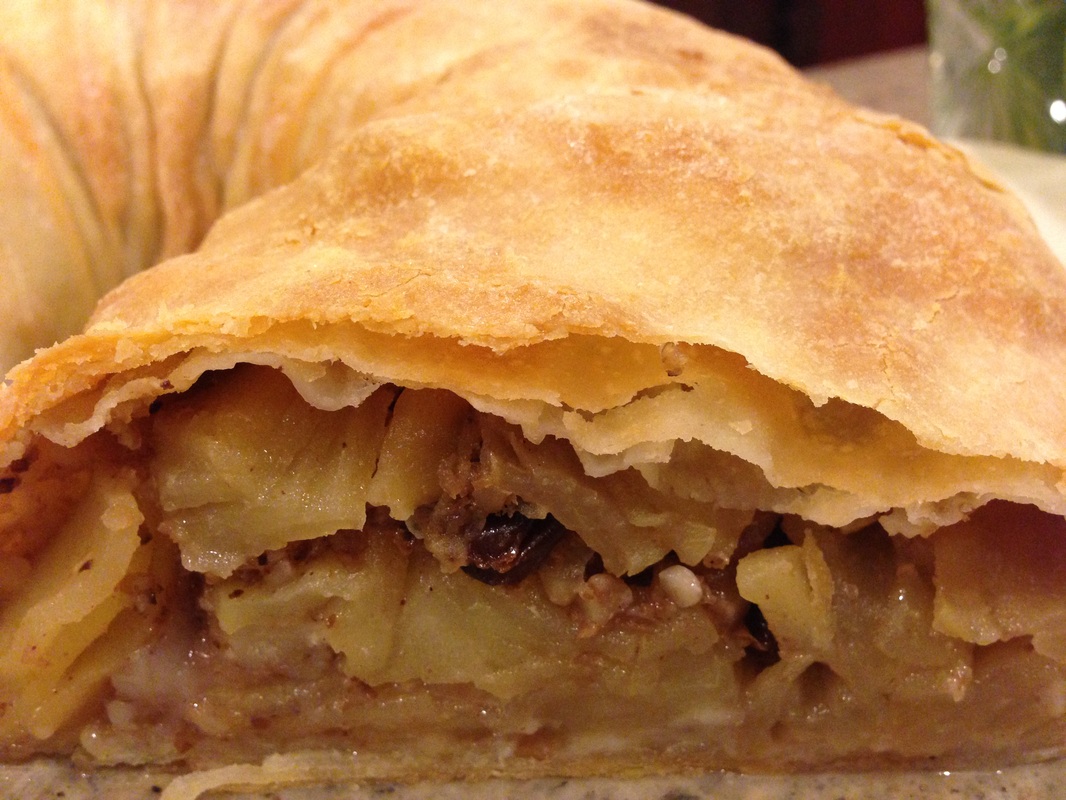 I only remember hearing about one person who made their own strudel, and that was the mother of Thelma Greenwald, one of our neighbors in Far Rockaway. It required painstakingly stretching dough on top of a flour dusted tablecloth draped over a kitchen or dining room table. I hadn't thought about strudel in a very long time until my recent travels to Vienna. Despite a touch of lingering jet-lag, I am here to share a recipe for strudel. I just dove in, tablecloth draped over my kitchen counter, a very liberal dusting of flour and my trusty rolling pin. I lived to tell the tale and happily consume the strudel. The Dough (adapted from The Good Cook 'Pies & Pastries,' The Culinate Kitchen and Specialties of Austrian Cooking by Lotte Scheibenpflug) 2 1/4 cups bread flour 1 teaspoon salt 2 tablespoons unsalted butter, melted and cooled plus 1 tablespoon for brushing the dough 3/4 cup lukewarm water 1 egg, beaten 1/2 teaspoon fresh lemon juice In the bowl of a standing mixer fitted with the paddle attachment, combine the flour, salt, 2 tablespoons of melted butter, water, egg and lemon juice. Mix on low speed for 5 minutes until all of the flour is incorporated and you have a smooth, elastic dough. Mix on low for an additional 5 minutes or if you are more of a hands-on kneader, turn the dough out onto a well floured board and knead the dough until smooth and shiny. Place the dough in a well greased bowl, brush it generously with the additional tablespoon of melted butter, cover it with plastic wrap, and let it rest for at least 30 minutes. Cover a large table or a kitchen counter (an island so you can walk around it) with a clean tablecloth. Using a sifter or a mesh strainer, liberally cover the tablecloth with flour. Place the dough in the center of the tablecloth and working in all directions, roll out the dough as thin as possible. Carefully place your hands, knuckle-side up, under the dough and very gently stretch the dough, working carefully all around the table. The dough needs to be thin enough to see through- my dough measured 28"x36". Don't worry if you encounter an occasional tear. Brush the rolled and stretched dough with 5 ounces of melted, cooled butter. The filling 3 &1/2 lbs. apples, peeled, cored, thinly sliced 1 teaspoon fresh lemon juice 1/2 cup sugar combined with 1/4 teaspoon cinnamon 1/2 cup walnuts, finely chopped 1/2 cup fine bread crumbs 1/4 cup raisins (optional) Toss the apple slices with the lemon juice. Once you have brushed the rolled, stretched dough with the melted butter, leave a 1 inch border, then sprinkle half of the breadcrumbs along one of the short ends of the dough. Place half of the apples on top of the breadcrumbs, sprinkle with half of the cinnamon sugar, the walnuts and the raisins (if you are using them.) Then place the remaining apples and cinnamon sugar on top of the filling. Using the tablecloth as a guide, drape the short end of the dough over the mounded filling, then carefully lift the tablecloth which will help roll up the dough, jelly-roll style, until the filling is completely enclosed in the pastry. Tuck in the ends and don't be afraid- it will be delicious even if it is less than perfect! Pre-heat the oven to 375 degrees. Carefully (it helps to have an extra set of hands) curve the rolled strudel onto a parchment lined baking sheet. Brush the strudel liberally with additional melted butter (about 2 tablespoons should do it.) Bake the strudel at 375 degrees for 35 minutes, reduce the heat to 350 and bake for an additional 20 minutes. Serve the strudel warm, preferably with whipped cream or with a dusting of powdered sugar. |
Archives
July 2024
|
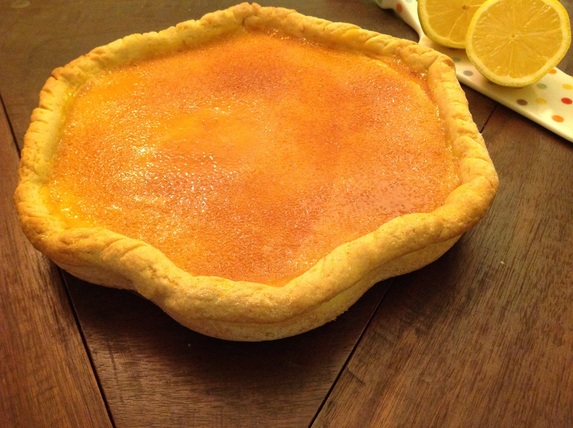
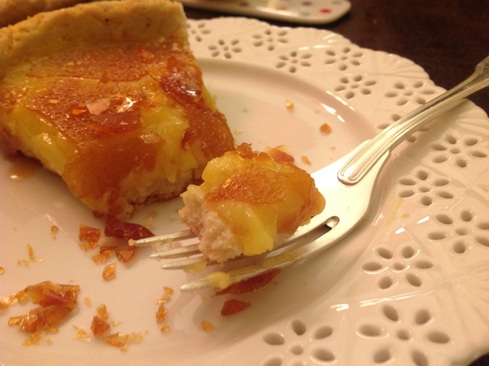
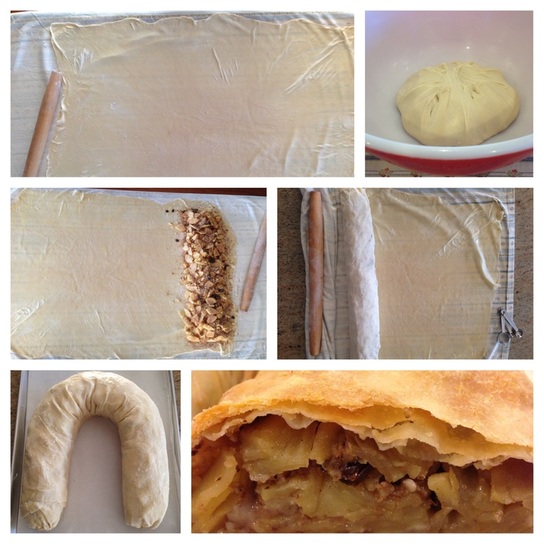
 RSS Feed
RSS Feed